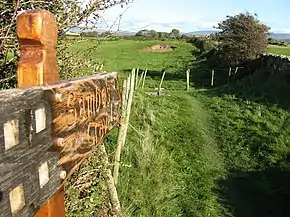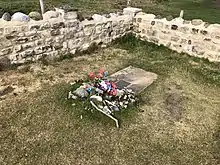Sambo's Grave
Sambo's Grave is the burial site of a black cabin boy or slave on unconsecrated ground in a field near the small village of Sunderland Point, Lancashire, England. Sunderland Point was a port, serving cotton, sugar and slave ships from the West Indies and North America, which declined after Glasson Dock was opened in 1787. It is a very small community only accessible via a narrow road, which crosses a salt marsh and is cut off at high tide.

History

In the early 18th century Sunderland Point was a port for Lancaster serving ships too large to sail up to the town.[1] According to the Lonsdale Magazine of 1822,[2] which appears to rely on the then oral history,[3] Sambo had arrived around 1736 from the West Indies as a servant to the captain of an unnamed ship:
After she had discharged her cargo, he was placed at the inn…with the intention of remaining there on board wages till the vessel was ready to sail; but supposing himself to be deserted by the master, without being able, probably from his ignorance of the language, to ascertain the cause, he fell into a complete state of stupefaction, even to such a degree that he secreted himself in the loft on the brewhouses and stretching himself out at full length on the bare boards refused all sustenance. He continued in this state only a few days, when death terminated the sufferings of poor Samboo. As soon as Samboo's exit was known to the sailors who happened to be there, they excavated him in a grave in a lonely dell in a rabbit warren behind the village, within twenty yards of the sea shore, whither they conveyed his remains without either coffin or bier, being covered only with the clothes in which he died.
— Lonsdale Magazine, 1822
It has also been suggested that Sambo may have died from a disease to which he had no natural immunity, contracted from contact with Europeans.[4] He was buried in unconsecrated ground (as he was not a Christian) on the weatherbeaten shoreline of Morecambe Bay.[5]
Plaque
| Part of a series on |
| Slavery |
|---|
 |
With the opening of Glasson Dock in 1787, trade ships deserted Sunderland Point and it became a sea-bathing place and holiday venue.[1] Sixty years after the burial, a retired headmaster of Lancaster boys' grammar school, James Watson, heard the story and raised money from summer visitors to the area for a memorial, to be placed on the unmarked grave.[1] Watson, who was the brother of the prominent Lancaster slave trader, William Watson, also wrote the epitaph that now marks the grave (note the use of ſ, the long s character, and the eccentric and inconsistent spelling typical of the time):[6]

|
Here lies |
|
Full sixty Years the angry Winter's Wave Full many a Sandbird chirps upon the Sod But still he sleeps _ till the awakening Sounds James Watſon Scr. H.Bell del. 1796 |
The present plaque is a modern replica, replacing the original which had been stolen.[7] This is explained by a smaller plaque, set immediately above the main plaque, which reads:[6]
|
Thoughtless and irreverent people having |
Preservation

Official signposts on Sunderland Point define the grave and locality as a tourist attraction. The grave almost always bears flowers or stones painted by local children.[1][5][8] The grave was enclosed by a low stone wall in 2019 and Chris Drury's 'Horizon Line Chamber' was built on the approach path.
References
- Howard, Peter F. (2008). The Ashgate research companion to heritage and identity. Aldershot: Ashgate Pub. Co. pp. 56, 57. ISBN 0-7546-4922-9.
- Hodgson, Liz (February 2007). "Sambo's Grave, Lancaster". Commemorating Abolition. University of Central Lancashire. Archived from the original on 18 January 2008. Retrieved 30 August 2010.
- Handlist 69: Sources for Black and Asian history (PDF). Lancashire Record Office (Report). April 2010. pp. 5–6. Retrieved 10 May 2019.
- Anon (2005). "Sunderland Point and Samboo's Grave". Mostly-Victorian. E. Ashworth. Retrieved 6 December 2013.
- Anon (2007). "Sambo's grave at Sunderland point". Pandora's box. Little Frank. Retrieved 30 August 2010.
- Thomason, N. (24 July 2005). "Sambo's grave, near Sunderland point". The Ministry of Information – the blog. Retrieved 30 August 2010.
- Hartwell, Clare; Pevsner, Nikolaus (2009). Lancashire: North. Pevsner Architectural Guides. New Haven: Yale University Press. p. 662. ISBN 9780300126679.
- Oldham, Sophie (2016). "Remembering the Enslaved at Home - Slave Burials in Britain from 1701 to 1868" (PDF). Department of History. Newcastle University. Retrieved 10 May 2019.
External links
 Media related to Sambo's Grave at Wikimedia Commons
Media related to Sambo's Grave at Wikimedia Commons- Sunderland Point and Samboo's Grave
- "Sambo" 1657, antedates OED 1704-
- The Graves of Slaves & other Black People in 18th C Britain